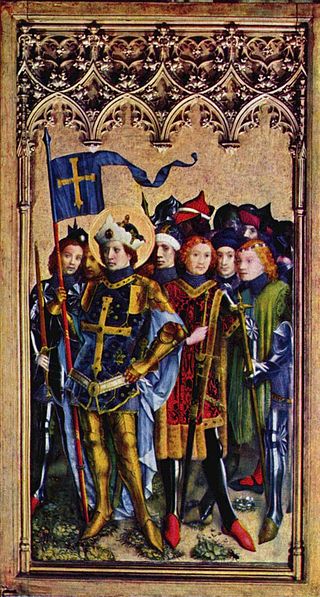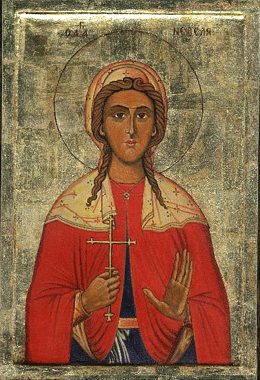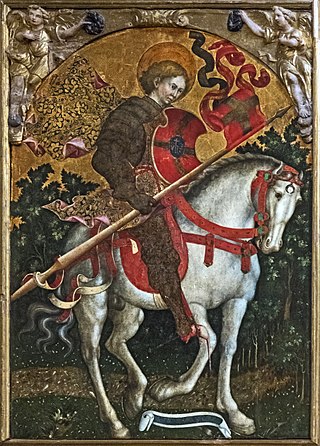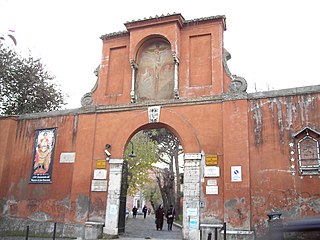
Agnes of Rome is a virgin martyr, venerated as a saint in the Catholic Church, Oriental Orthodox Church and the Eastern Orthodox Church, as well as the Anglican Communion and Lutheran Churches. She is one of several virgin martyrs commemorated by name in the Canon of the Mass, and one of many Christians martyred during the reign of the Roman emperor Diocletian.
The 300s decade ran from January 1, 300, to December 31, 309.

Year 303 (CCCIII) was a common year starting on Friday of the Julian calendar. It was known in the Roman Empire as the Year of the Consulship of Diocletian and Maximian. The denomination 303 for this year has been used since the early medieval period, when the Anno Domini calendar era became the prevalent method in Europe for naming years.

Agathaof Sicily is a Christian saint. Her feast is on 5 February. Agatha was born in Catania, part of the Roman Province of Sicily, and was martyred c. 251. She is one of several virgin martyrs who are commemorated by name in the Canon of the Mass.

The Theban Legion figures in Christian hagiography as a Roman legion from Egypt —"six thousand six hundred and sixty-six men" — consisting of Christian soldiers who were martyred together in 286, according to the hagiographies of Maurice, the chief among the Legion's saints. Their feast day is held on September 22.

Pancras was a Roman citizen who converted to Christianity and was beheaded for his faith at the age of fourteen, around the year 304. His name is Greek, meaning 'all-powerful'.
Cyriacus, sometimes Anglicized as Cyriac, according to Christian tradition, is a Christian martyr who was killed in the Diocletianic Persecution. He is one of twenty-seven saints, most of them martyrs, who bear this name, of whom only seven are honoured by a specific mention of their names in the Roman Martyrology.

October 5 - Eastern Orthodox liturgical calendar - October 7

Saint Kyriaki, also known as Saint Kyriaki the Great Martyr, is a Christian saint, who was martyred under the emperor Diocletian.

Eulalia, co-patron saint of Barcelona, was a 13-year-old Roman Christian virgin who was martyred in Barcelona during the persecution of Christians in the reign of emperor Diocletian. There is some dispute as to whether she is the same person as Eulalia of Mérida, whose story is similar.

Martinian and Processus were Christian martyrs of ancient Rome. Neither the years they lived nor the circumstances of their deaths are known. They are currently buried in St. Peter's Basilica in Rome.

Saint Chrysogonus is a saint and martyr of ancient Rome venerated by the Catholic Church and the Eastern Orthodox Church.

Devota is the patron saint of Corsica and Monaco. She was killed during the persecutions of the Roman Emperors Diocletian and Maximian. She is sometimes identified with another Corsican saint named Julia, who was described in Latin as Deo devota. The description was misinterpreted as a proper name. The legend connected with her is similar to those told of other saints of the region, such as Reparata and Torpes of Pisa.

Saint Honorina was a 3rd-century virgin martyr of Gallo-Roman northern France, venerated as a saint in the Catholic and Eastern Orthodox Churches. Believed to have been killed in the first years of the 4th century during the persecutions of Diocletian, very little is known of her life, apart from her reputed martyrdom for maintaining her Christian faith.

Alexander of Bergamo is the patron saint of Bergamo, as well as Capriate San Gervasio and Cervignano d'Adda. Alexander may have been a Roman soldier or resident of Bergamo who was tortured and killed for not renouncing his Christian faith. Details of his life are uncertain, but subsequent Christian stories consider him a centurion of the Theban Legion commanded by Maurice.
Rictius Varus was a Vicarius in Roman Gaul at the end of the 3rd century, around the time of the Diocletianic Persecution. The Roman Martyrology contains many references to the prefect Rixius Varus, who is said to have persecuted hundreds of Christians. In Christian hagiography he later repented and became a Christian martyr himself, and is regarded a Saint in the Eastern Orthodox and Roman Catholic Churches, with his feast day on July 6.

December 9 - Eastern Orthodox liturgical calendar - December 11

The Catacomb of San Pancrazio is a catacomb of Rome (Italy), located in the Via Aurelia, within the modern Quartiere Gianicolense.

Madonna and Child with Saint Dominic and Saint Martha of Bethany is a 1517-1520 oil on canvas painting by Andrea Previtali produced for the monastery of Santa Marta in Bergamo and since 2010 in the collections of the UBI Banca in Bergamo.
Maria Aurelia Tasso or Tassis was a Benedictine nun at the monastery of Santa Grata in Bergamo. She likely derives from the same Bergamese family as Torquato Tasso. She wrote a hagiography on Santa Grata of Bergamo, putatively a 4th century saint. In that text she comments on Bernardo Tasso's sister Dona Affra, who also was a member of the same monastery.














